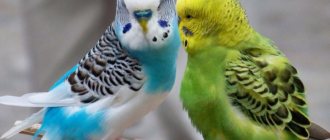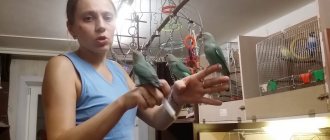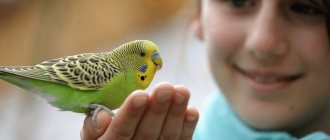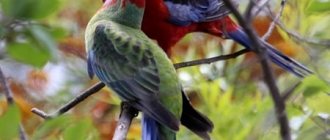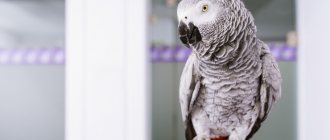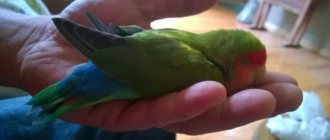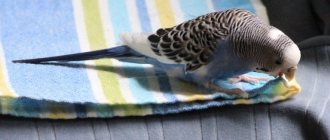Studying the body language of parrots
Parrots are often chosen as the first feathered pets. There is a logic to this - parrots are quite unpretentious in care and maintenance, have an exotic appearance, and many learn to “speak.” But not everything goes smoothly! As evidenced by the editorial mail, owners often complain about the “melancholic” mood of their pets, noting that they seem to lose interest in life and soon die. An article from our British colleagues arrived very opportunely! Let's try together to understand the nuances of parrot behavior!
The parrot sings and whistles all the time. Let's take a closer look at the parrot. How does he spend his time? Sings, whistles, makes other joyful sounds? Then there is nothing to worry about - the bird feels happy. As people say, a real parrot does not shut up even when it goes to bed!
Parrots generally enjoy the sound of their own voice. So, if your pet is surrounded by constant noise, know that he lives in complete harmony!
Other sounds. So, we know that the sound repertoire of parrots is quite rich - they sing, and mutter, and click, and clatter, and even growl dully. Let’s dwell on the last sound in more detail, because this is the highest degree of happiness for your parrot! The purring of a parrot is similar in meaning to the purring of a cat or the wagging of a dog's tail. It’s another matter when, instead of a “dull growl,” you hear a distinct, ringing growl! Not all parrots make this sound, but know that this is a characteristic warning signal that the bird is irritated or unhappy.
By loudly clicking its tongue, the parrot makes it clear: it is time to pay attention to it. You can just talk to him about different topics or even let him out of the cage to stretch his feathers.
Certain species of parrots make loud and rather unpleasant rattling-squealing sounds. You have to get used to these sounds! They indicate either excitement, anger or fear.
How does the parrot behave? Most often, parrot owners complain about their pets self-plucking feathers. Let's limit ourselves to general advice: you should learn to distinguish between the period of molting (when the loss of feathers is a natural process) and the truly stressful state of the bird. In the latter case, the pet looks pitiful - as if it had been seriously beaten by a moth.
In general, the condition of your pet’s feathers can tell you a lot. If, in particular, your feathered friend looks hunched over, stooped, and his feathers stick out in different directions, he is most likely tormented by internal problems and is clearly not healthy.
Look at your pet’s comb (tuft), if any. The bird is noticeably tense, and its crest stands up, indicating that it is very alarmed by something and is ready to defend itself.
What will our eyes tell us? Look into the parrots' eyes more often! Experts say that the eyes of these birds “wink.” In practice, monitor the position of the eyes and superimpose it on the body positions of the bird that we already know. In this case, much from the world of emotions of a feathered pet will be revealed to an attentive observer. Watch how the eyes “run”, what position the bird itself is in, what sounds it makes. And draw conclusions!
Finally, about behavior. It should be noted that little can be hidden from an attentive owner! In between, pay attention to what is going on in the cage. Your pet is busy with something, entertains itself, sings and chirps - it’s quite good for him. Be wary when you see a bird sitting sadly and sadly on its perch. It's hard not to notice! Indeed, it can be stated that the parrot has lost interest in life, is unhappy or even sick.
See how your pet reacts to your approach to the cage. He is actively happy, making noise, his eyes are sparkling, which means everything is going great. The bird remains indifferent, which means it’s time to sound the alarm. Start looking for the reasons - when it all started, what circumstances accompanied it.
Source
How to understand a budgie
Parrots are magnificent birds that delight the eye with their beautiful plumage and intelligence. The developed brain of winged birds allows them, through their habits, to communicate to their owner about their own mood, desires, and dissatisfaction. A sound signal in the form of a scream or chirp will tell the owner about the mood of his pet today.
These birds happily participate in games and solve “arithmetic” problems. However, often breeders do not know how to understand a parrot. As a result, the birds' needs are left unattended.
How to understand a budgie
You can learn the language of the wavy ones if you regularly talk to them. The birds are very sociable and enjoy interacting with their owner, family members and other pets: cats, dogs.
How to understand a parrot
A parrot's gestures can be active, cheerful, or express aggression and resentment.
Thanks to their high intelligence, winged birds are able to make different sounds and words. Calm movements, quiet chirping or singing indicate the health and good mood of the pet. Screams, hissing, flapping wings are the first and discontent. The bird is inactive, hunched, wheezing or screaming - this means it is not healthy.
What do the different sounds mean?
The speech of parrots can be quite developed. With constant practice, they imitate human language, the sounds of a melody, the barking of dogs or the creaking of doors, etc. Sometimes they pronounce entire phrases clearly.
Read also
How to put a parrot in a cage if it is not tamed.
Based on intonation, the dialect can be divided into subgroups:
- chirping;
- scream;
- singing, cooing;
- rumble;
- mating at the beginning of the mating season;
- mumbling.
Indications of the sounds that parrots make
Measured singing indicates a good mood of the pet. The sound tone is not annoying, it is quiet and unobtrusive. The observer may hear something similar to “tuyu-tuyu-chvik.” At these moments, it is better not to disturb the winged one, not to disturb his communication with himself.
Individuals of different sexes, living together in the same cage, produce sounds similar to rustling, rumbling or chattering. This means that contact between them has been established, and the birds are enjoying each other.
Beeping and chirping indicates that the pet is calm, but at this moment it is experiencing curiosity and trying to find out what is happening around. Perhaps he is watching his owner's actions or is surprised. The sound should be pronounced "peek", "chwik", "pew" or "chirp".
“Cha-cha-cha” is the sound that even an inexperienced breeder will pay attention to. He points out the excitement of his winged friend. There are two reasons for this:
- Irritation and dissatisfaction.
- Great and playful mood.
Indications of what a scold says
When meeting a bird, especially if it is picked up, the owner may hear something similar to “quack”. This indicates that the parrot is asking to be left and not disturbed for a while.
Having played enough for the day, the birds fall asleep. The process is accompanied by a quiet rumble of “kwe”, “e”.
Why do parrots open their wings?
Extending the wing and leg to one side is a welcoming gesture. It’s as if he’s trying to say with movement rather than words: “Hello, I’m glad to meet you.”
Another welcoming gesture is the feathers flowing and the tail wagging. The parrot, which quickly turns its tail, is glad to see you. A kayak-like species may even begin to thrash the perch. The calmer and larger the parrot, the less actively it shows its joy. It is difficult to describe the exact difference between feathers flown with pleasure and feathers flown in an aggressive manner.
Another sign of affection is a parrot that flies straight towards you without calling you. Birds are more curious if they are calm and not afraid of you.
To tame birds with this gesture, you should bend down in greeting every morning, at your first sight with him. Soon the parrot will copy you and will also wave its head when it meets you. My budgie often hangs his head to one side.
Redness of the military poppy. Some parrot species can blush just like humans. Mina, my parrot, (Ara militaris) blushes whenever she is happy, amused or scared. The first blush was noticed at ten weeks during his first visit to the vet. He was nervous. Now he blushes slightly, usually as a greeting when he sees a person of privilege. This is a feature of the species.
The most accurate method is DNA analysis
The DNA test guarantees the accuracy of the research. With its help, the probability of distinguishing the gender of budgerigars is very high. Feathers, blood, and egg shells are suitable for analysis. In terms of the reliability of the result, blood and feathers are identical, but the shell is only suitable if the inner membrane is preserved.
Tips for collecting feather material:
Important: if there are drops of blood left on the feathers, they should not be washed off. Such material is suitable for analysis.
Instructions for taking blood samples:
After the manipulations, the material is sent to the laboratory.
DNA testing is expensive, exceeding the price of the bird itself. This method is rarely used, mainly if it is important to determine the sex of parrots. It is not advisable to order a DNA testing procedure just out of curiosity.
It is more difficult to tame an adult bird than a young one. If you need a feathered pet to teach it to imitate human speech, choose a male at the age of three to four months. Now you have complete information on how to determine the sex of a budgie.
Why do parrots shake their heads?
Head shaking is a child's behavior. Chicks wave their heads when asking for food, but this habit often carries over into adulthood. A budgerigar's head shaking and shaking is often a sign of mating. When a parrot wants you to stroke its head, it will shake it. Or your bird just wants food.
Why do budgies stand on one leg?
The one-legged stand is a common sleep position that you can observe throughout the day. A gesture of relaxation to reduce the amount of heat lost. You will find that your parrot may stand on one leg with the other tucked up.
Another sign of relaxation is relaxed body feathers that are held loosely, not tensely.
Genetic diagnosis of sex
One of the most reliable ways to distinguish between female and male budgerigars is genetic research. This method of sex determination is based on the study of the properties inherent in the bird: the number of chromosomes in males and females differs. This only works in a few varieties resulting from gene mutation:
The chromosome set is checked in the laboratory, but even at home, you can sometimes distinguish a boy from a girl parrot by the color of its feathers. To do this, the chick must grow feathers. In this case, it is necessary to see a couple of breeding birds, that is, this method is suitable for breeders.
Why do parrots moo?
Mooing is a sign of affection, but it is a fairly rare sound. None of my birds have ever mooed. This is not to be confused with the low growling sound you might hear from a frightened bird.
It’s an amazing process when a budgerigar’s pupils dilate. Some parrots do this when they are excited about something they like, such as a new toy or tasty food. They say that birds that talk squint their eyes - but not all parrots that squint their eyes will talk.
A frightened parrot may growl. Her feathers will be held tightly against her body, there will be no eye contact, and her feathers will be retracted.
Summarizing
A budgie, like any other pet, requires sufficient time and attention from its owner. If the owner is patient and regularly works with his pupil, then soon the training will bear fruit - the bird will speak, repeating not only individual words, but also entire sentences. He will copy intonation, surrounding sounds, and delight family members with dancing and cheerful singing.
An attentive owner who has studied the habits of a feathered pet will be able to find a common language with it. This will make it comfortable for both the bird, whose needs will be understood and satisfied, and the owner, who can quickly determine by the behavior and singing of the budgerigar his emotional state, the cause of anxiety or joy.
Sources:
https://zoolog.guru/pticy/domashnie-pticy/popugai/chirikane-volnistogo-popugaya-o-chem-ono.html https://popugai.info/penie-volnistyx-popugaev/ https://100popugaev.ru /volnistye/penie-i-chirikanje
